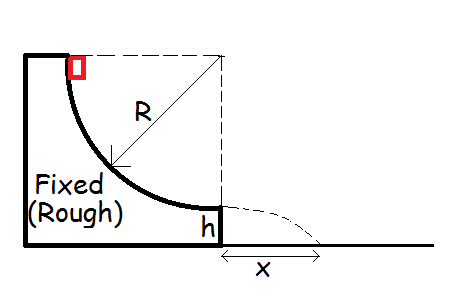A classical mechanics problem by rahul singh

Consider a fixed wedge whose part is a quarter circle of radius R as shown. A small block of mass m slides down the wedge and leaves horizontally from a height h as shown. the coefficient of friction between wedge and block is k. compute the value of x in millimetres , where x is the distance from the bottom of the wedge of the point where the block falls given the values below:
Details - R = 200cm - h = 105 cm - k = 0.5 - m = 2g - Round your answer in centimetres to nearest integer and then enter it in millimetres
The answer is 890.
This section requires Javascript.
You are seeing this because something didn't load right. We suggest you, (a) try
refreshing the page, (b) enabling javascript if it is disabled on your browser and,
finally, (c)
loading the
non-javascript version of this page
. We're sorry about the hassle.
First, we make the force diagram at the instant when then angle made by line joining center of circle, and block with horizontal is A . The force diagram would be as shown. Let the speed of the block at this instant be v. Clearly, there would be two components of acceleration , centripetal and tangential.
We know that centripetal acceleration is given by r v 2 , hence we use Newton's law to get: N - mgsinA = r m ( v 2 )
We know that , . f = kN
f = k(mgsinA + r m ( v 2 ) )
Now, tangential acceleration = d t d v = 2 r d A d ( v 2 ) , hence, using Newton's law,
mgcosA - k(mgsinA + r m ( v 2 ) )= m 2 r d A d ( v 2 )
Rearrange and divide by m to get: d A d ( v 2 ) + 2k(v^2) = 2Rg(cosA - ksinA)
Clearly, this is a Linear Differential equation in A and .
Integrating factor = e^(2kA)
Solving, we get: x = 89cm = 890mm